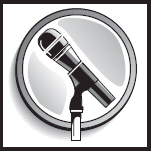
CHAPTER 7
Vocals Setup

When setting up for the vocals, the most important factors are the singer's comfort and confidence. Preparing a vocal station is the key. The singer should be able to walk in, put on her favorite set of headphones, and sing the vocals with everything exactly right. Set out whatever will be needed to keep her relaxed and comfortable, perhaps:
• A carpet on the floor and a chair or stool.
• Some candles or incense.
• Posters of their influences.
• A small table with some water, tea, or spirits.
• A box of tissues and a trash bin.
• Dim the lights and set the temperature of the room.
• A copy of the lyrics with a pencil for any last minute changes.
• A lighted music stand to see the lyrics.
• Perhaps a daring photo of yourself.
Choose the best microphone for the situation. Of course, every situation is different. If you are recording a slow song with a lush arrangement, maybe try a tube microphone for a fuller, richer sound. If you are recording, say, a punk vocal, perhaps a sharper, brighter microphone is in order. If you are recording a reference vocal with the live track, commonly whichever microphone is left in the closet is the one used. That being said, the live vocal may capture a feel and emotion because of the live band that may not be felt when the singer is alone in a studio.
Because everyone's voice sounds different, it can be difficult to choose the best microphone until you hear the singer sing the song into each one. Unless you are totally familiar with the microphones, it is common to set up all of the studio's vocal microphones. One microphone will emerge as the choice one. Commonly, cheaper microphones don't sound as good as expensive microphones. To find the best microphone for the singer and the song:
(1) Set up all the available microphones.
(2) Remove all pads and roll-offs. Set a similar polar patter, such as cardioid, for all microphones. Place the microphone capsules as close to each other as possible so the voice arrives at the capsules at the same time.
(3) Because people associate louder with better, set the input trim levels so all microphones are the same volume.
(4) Ask the singer to sing the song you are about to record, then work backwards to individually eliminate the unsuitable microphones until the choice one remains.
• Don't be afraid. We have all heard that a good vocal comes from an expensive pristine condenser microphone. Well, that's not always true. Sometimes a singer who really belts it out needs a dynamic microphone. Maybe he needs a ribbon microphone. Maybe the singer is used to holding a certain microphone on stage and that's how he wants to record. Maybe he has heard that his favorite singer uses a certain dynamic microphone so that's the one he wants. The only rule that dictates is to make the singer sound the best for your situation. The way to make him sound best is to make him happy.
• Set up a vocal station for the duration of the project. Maybe have it ready, but placed to one side. When the time for vocals hits, the assistant can quickly grab it and move it into place. On days when the singer gets the urge to belt one out, everything will be ready to go.
• Use an open space with baffles. To get a tight, dry sound, place baffles a few feet behind and beside the singer. The surrounding environment should be live enough to create a natural ambient sound, yet not overly reflective.
Some engineers prefer a totally dead sound; others go the other way, using a larger area for the vocal to give it natural depth and placement. If the singer is in a natural-sounding room, a hint of ambiance can give a vocal track more life – especially background vocals.
• Avoid tiny spaces for vocals. A claustrophobic environment can do more harm than good. The singer's comfort takes precedence over microphone technique. In addition, placing the singer in a small booth may color the sound. A good microphone in a small booth might pick up the lower midrange room reflections, especially with male singers, as their voices tend to be lower.
• Don't use the bathroom. Put a singer in a small, absorbent situation, rather than a reflective situation such as a washroom. As with acoustic instruments, once those natural echoes are recorded on the vocal track they cannot be removed. The effect can always be recreated if the vocal is recorded in a more natural-sounding environment.
• Mike's in the ladies room. Another reason not to place a microphone in the washroom is the privacy issue. People expect privacy. Plus, some rather dodgy deeds have been known to occur in recording studio washrooms.
Placing the Microphone
• There is no one microphone that works best for everyone. For a jazz session, you might want a warm, full-sounding microphone. For a rap session, you may want an edgier, brighter microphone. A female singer might get a different microphone from a male singer.
• Does the sound sound sound? Maybe a player with a degree of studio experience will request certain microphones on their vocal or instrument. If you disagree and use a different microphone, guaranteed the player will not like the sound. Keep him happy and use his microphone, even if you feel the sound is compromised.
• The singers hide. Some singers do not want to be seen when they sing – even by the engineer. Ask him if he would be more comfortable behind a screen or facing away from the control room, or maybe in total darkness. It's his choice.
• Choose your pattern. If recording one singer, a cardioid pattern may work best. Two singers opposite each other may need a figure-8 pattern. With four singers around one microphone, an omnidirectional pattern may work best. If the singer likes to jump around a lot in the studio, maybe try an omnidirectional pattern.
• I'm shocked. Shocked! A microphone installed on a proper shock-mount eliminates much of the room rumble. When no shockmount is available for the vocal microphone, use a roll-off. Note that roll-offs are internal microphone filters and can color the sound.
• Hang ‘em high. Depending on the microphone, try hanging it from a boomstand so the capsule dangles rather than sits. This can also make room for the singer to see the music stand, plus he won't be tempted to hang the headphones on the stand when the vocal track is done.
• Patience is a virtue. Take a few extra minutes to set up a few microphones and placements to determine which works best with the song and the singer's particular style. Figure 7.1 shows six common methods of placing the vocal microphones:
(a) Six to eight inches in front. This setup tends to be a great starting point, as the distance adds a warmth that may be lost with close miking. It can mean less compression is needed if the singer knows what he is doing and can control his dynamics.
(b) Quite close. For a very intimate vocal, place a singer's microphone a few inches away from the mouth to record all the little nuances of the vocal. This works when the vocal track is dynamically consistent and the singer doesn't suddenly yell into the microphone. Both condenser and dynamic microphones record well when close miked. Perhaps set up a windscreen.

Microphone placements
(c) Over a foot away in front. Placing the microphone further away, beyond 12 inches, captures the ‘air’ that can get lost from being too close. Condenser microphones might work better than dynamic microphones. This setup works if the singer moves around a lot while recording, due to the distance between singer and microphone.
(d) Perpendicular to the nose. Place the microphone so the front, or pickup, surface is positioned directly parallel with the top of the singer's nose and aimed at or around the singer's mouth so no nasal tone will be registered The off-axis placement keeps sibilance from hitting the capsule square on. A windscreen is suggested, but may not always be necessary.
(e) Perpendicular to the nose, over a foot away. Works well in small absorbent spaces and in very dynamic situations where vocals go from soft to loud. In addition, the singer can read the lyrics if the microphone is not directly in the way.
(f) Positioned underneath and aimed up at the mouth. Some singers like to lean into the microphone when they sing. Place the microphone a touch lower than the mouth, so the singer's head can bend down a bit. In addition, this is a natural way to capture resonance from the chest and body cavity.
• Background vocals. Use as few microphones as possible with background vocals. Try a single omnidirectional microphone or a pair of microphones for a group of singers. When they can see and hear each other, they will create a proper blend of harmonies between themselves. Listen for who is louder or softer and move each singer closer to or further from the microphone until the best balance is reached.
• Strip on the floor. Run a strip of tape across the carpet where the ideal spot in front of the microphone is and ask the singer not to cross that line as he sings. If he has great control of his dynamics, place him closer to the microphone. If he has less control, maybe place him a foot or two away and remember this when setting the limiter.
• Oral and hearty. In those unusual instances where the singer gets very dynamic, try different microphones for different sections of the song. For example, in a song with quiet verses and loud choruses, set up two adjacent microphones where one microphone has the input level set lower. Have him sing the song, then record each microphone onto separate tracks.
One track will have the verses just right with the choruses too loud and the other will have the choruses just right with the verses too quiet. Comp the verses from one track and the choruses from the other track to a separate master track. Or buss the microphone to two channels and set different levels for each track, one louder and one quieter.
• Who has screen the wind? A windscreen, or pop filter, stops the flow of air across the microphone's capsule. Some engineers argue that this colors the sound so, rather than use a pop filter, they position the capsule away from the singer's mouth.
To keep a singer from getting too close to the microphone, maybe attach the pop filter to its own stand and place it at the proper distance from the microphone. This creates a barrier to allow for sufficient space between the singer and the microphone. The best recordings come from the singer staying at a consistent distance from the microphone.
• Wash it, will ya? Occasionally, replace the mesh across the pop filter and wash or replace the windscreens, especially if they are being used on a regular basis. With different singers spitting and breathing into it, it may become a little rank.
• Keep pops out of the studio. As a last resort, attach a pencil in front of the microphone so it splits the pressure and diverts it away from the membrane inside the capsule.
• Take time to find the best pre-amp for the vocal. Just as microphones have different sounds, so do pre-amps, equalizers, and compressors. Due to the nature of physics, every device contributes a tiny amount of distortion. Inexpensive equipment, such as cheap pre-amps, contains inexpensive circuitry, which introduces distortion earlier.
• Listen to the microphones through a set of headphones. Because digital recording is so clean, the quietest air conditioner or the smallest toe tap will be clearly picked up. Listening with headphones will expose any errant sounds coming through the microphones.
• Give the singer tight-fitting closed-back headphones. If a singer wearing open-back headphones leans in too close to the microphone, the resulting feedback can do serious damage to the singer's ears and to your perceived ability to control feedback.
• Reflections. Place a towel (or something similar) on the music stand to absorb the reflections so the signal does not reflect back into the microphone and color the sound.
• Use the force. All singers are different. Some have fine technique and know how to work a microphone. Others use brute force. Try different placements, and find the spot that is most comfortable with the singer, yet that works for you sonically. When the singer is happy with everything, the session goes smoother and everyone benefits.
• Cue less. Try sending the singer a cue mix with less instruments, such as a mix with just the bass and drums. This may encourage her to come up with additional melodies, lyrics, and ideas that might not surface if all the instruments are in the cue mix.
